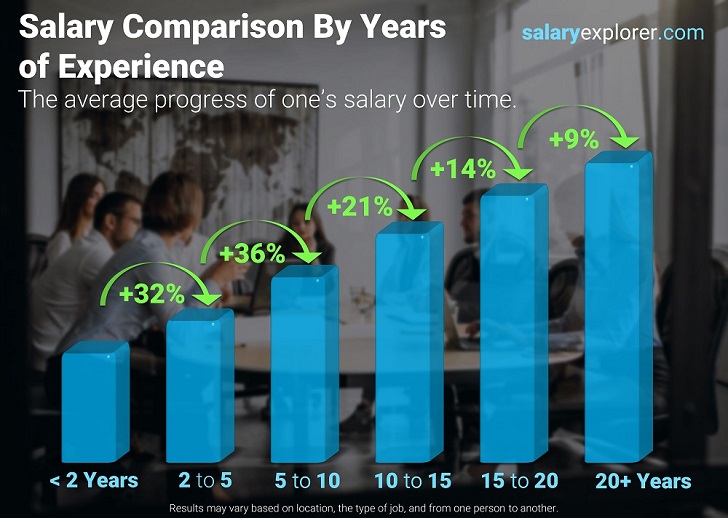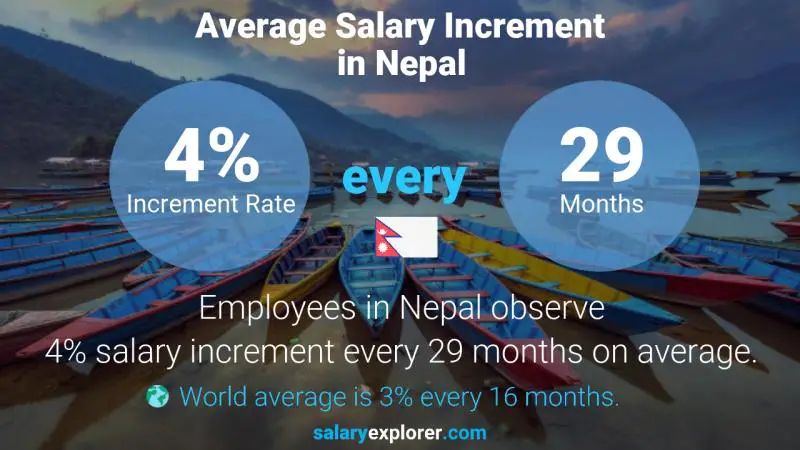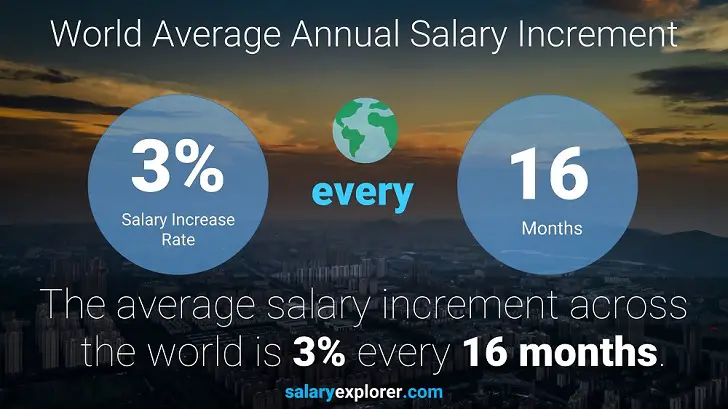Average Salary in Kathmandu 2024
How much money does a person working in Kathmandu make?

LOW
22,000
NPR AVERAGE
87,300
NPR HIGH
388,000
NPR
A person working in Kathmandu typically earns around 87,300 NPR. Salaries range from 22,000 NPR (lowest average) to 388,000 NPR (highest average, actual maximum salary is higher).
Salary Variance
This is the average salary including housing, transport, and other benefits. Salaries in Kathmandu vary drastically between different careers. If you are interested in the salary of a particular job, see below for salaries for specific job titles.
Pay Scale and Salaries in Kathmandu

Salary Structure and Pay Scale Comparison
165,000 NPR or more
129,000 to 165,000 NPR
50,300 NPR or less
50,300 to 129,000 NPR
 22,000 NPR |
 75,900 NPR |
 388,000 NPR |
Median Salary, maximum and minimum salary, minimum wage, starting salary, and the salary range
Salary Range, Minimum Wage, and Starting Salary
Salaries in Kathmandu range from 22,000 NPR (starting salary) to 388,000 NPR (maximum average salary, actual maximum is higher). This is not the minimum wage as per the law, only the lowest reported number in the salary survey that had thousands of participants and professionals from all over the country.
Median Salary
The median salary is 75,900 NPR, which means that 50% of the population in Kathmandu earns less than that while the other half earns more. The median represents the middle salary value. Generally speaking, you would want to be on the right side of the graph with the group earning more than the median salary.
Percentiles and Salary Scale
Closely related to the median are two values: the 25th and the 75th percentiles. Reading from the salary distribution diagram, 25% of the population in Kathmandu earn less than 54,800 NPR while 75% of them earn more. Also from the diagram, 75% of the population earn less than 115,000 NPR while 25% earn more than that.
Pay Scale Structure
We grouped the most common and recurring salaries into brackets to give more insight into what salary to expect. This method is more accurate than just the average salary and gives more insights into how salaries are actually distributed in Kathmandu. Around 65% of all reported figures are in the range 50,300 NPR to 129,000 NPR. Approximately 20% fall under the 50,300 NPR cap. Ten percent of wages are from 129,000 NPR to 165,000 NPR. Only 5% of people grossed 165,000 NPR or more.
Salary Comparison by Years of Experience
How does a person's salary progress over time?

Salary is primarily determined by the level of experience one possesses, with higher levels of experience resulting in higher wages.
In Kathmandu, employees with two to five years of experience typically earn an average of 32% more than entry-level and junior workers in all industries and fields.
Individuals with more than five years of experience tend to earn an average of 36% more than those with less than five years of experience.
After ten years of work, salaries increase by 21%, with an additional 14% increase for those who have worked for over 15 years.
These figures should be used as rough estimates, as considering individual job titles can lead to more accurate assessments.
Salary Comparison By Education
How does the education level affect your salary?

The correlation between higher education and higher salary is widely acknowledged, but how much of an income increase can one expect from obtaining a degree?
We conducted a study in Kathmandu comparing the salaries of professionals with different levels of college degrees who held similar positions in various industries.
Our results showed that individuals with a certificate or diploma earned an average of 17% more than those who only completed high school.
Those who obtained a Bachelor's Degree earned 24% more than their counterparts with a certificate or diploma.
Professionals with a Master's Degree earned 29% more than those with a Bachelor's Degree.
Finally, those who held a PhD earned an average of 23% more than those with a Master's Degree while performing the same job.
Is investing in a Master's degree or an MBA worth it? Is pursuing higher education worth the investment?
Earning a Master's degree or any post-graduate qualification in Nepal is a substantial financial commitment, with tuition fees ranging from 405,000 NPR to 1,220,000 NPR and a duration of around two years. It's important to note that during this period, any salary increases are unlikely, assuming ongoing employment. Salary reviews are typically conducted after completing the program and obtaining the degree.
Many individuals pursue advanced education as a means of transitioning to higher-paying positions, and the statistics indicate that this is an effective strategy. On average, individuals who change jobs after earning a higher degree receive a salary increase of about 10% more than the typical annual raise.
Ultimately, deciding whether or not to pursue advanced education depends on a variety of factors, including the personal situation and experience. However, if one can afford the financial costs of obtaining a higher degree, the return on investment is likely to be worthwhile, with the ability to recoup the costs in approximately a year.
Salary and Compensation Comparison By Gender / Kathmandu

Though gender should not have an effect on pay, in reality, it does. So who gets paid more: men or women? In Nepal, the average difference between the salary of male and female employees is 7% across all career fields.
| Male | 84,700 NPR | |
| Female | -7% | 79,000 NPR |
Average Annual Salary Increment Percentage in Kathmandu
How much are annual salary increments in Kathmandu? How often do employees get salary raises?
Nepal
Employees in Nepal are likely to observe a salary increase of approximately 4% every 29 months.

The term Annual Salary Increase usually refers to the increase in 12 calendar month period, but because it is rare that people get their salaries reviewed exactly on the one-year mark, it is more meaningful to know the frequency and the rate at the time of the increase.
How to calculate the salary increment percentage?
The annual salary Increase in a calendar year (12 months) can be easily calculated as follows: Annual Salary Increase = Increase Rate x 12 / Increase Frequency
Worldwide Salary Raises: All Countries and All Jobs

Salary Packages and Schemes
Not all compensation increases are reflected directly in the salary. Some companies offer upgraded packages to their staff instead of cash money. The figures displayed here account only for direct increments to the base salary.
Bonus and Incentive Rates in Nepal
How much and how often are bonuses being awarded? Share This Chart Tweet Get Chart Linkhttp://www.salaryexplorer.com/charts/nepal/annual-salary-bonus-rate-nepal.jpg
Share This Chart Tweet Get Chart Linkhttp://www.salaryexplorer.com/charts/nepal/annual-salary-bonus-rate-nepal.jpg
100% of surveyed staff in Nepal reported that they haven't received any bonuses or incentives in the previous year while % said that they received at least one form of monetary bonus.
Those who got bonuses reported rates ranging from % to % of their annual salary.
| Received Bonus | % | |
| No Bonus | 100% |
Types of Bonuses Considered
Individual Performance-Based BonusesThe most standard form of bonus, where the employee is awarded based on their exceptional performance.
Company Performance BonusesOccasionally, some companies like to celebrate excess earnings and profits with their staff collectively in the form of bonuses that are granted to everyone. The amount of the bonus will probably be different from person to person depending on their role within the organization.
Goal-Based BonusesGranted upon achieving an important goal or milestone.
Holiday / End of Year BonusesThese types of bonuses are given without a reason and usually resemble an appreciation token.
Bonuses Are Not Commissions!
People tend to confuse bonuses with commissions. A commission is a prefixed rate at which someone gets paid for items sold or deals completed while a bonus is in most cases arbitrary and unplanned.
Bonus Rates Comparison by Career Field
| Finance | High | |
| Architecture | High | |
| Sales | High | |
| Business Development | High | |
| Marketing / Advertising | High | |
| Information Technology | Moderate | |
| Healthcare | Moderate | |
| Insurance | Moderate | |
| Customer Service | Moderate | |
| Human Resources | Moderate | |
| Construction | Low | |
| Transport | Low | |
| Hospitality | Low |
What makes a position worthy of good bonuses and a high salary?
The main two types of jobs | |
| Revenue Generators | Supporting Cast |
Employees that are directly involved in generating revenue or profit for the organization. Their field of expertise usually matches the type of business. | Employees that support and facilitate the work of revenue generators. Their expertise is usually different from that of the core business operations. |
Example: | Example: |
Revenue generators usually get more and higher bonuses, higher salaries, and more frequent salary increments. The reason is quite simple: it is easier to quantify your value to the company in monetary terms when you participate in revenue generation.
Bonus Comparison by Seniority Level
Top management personnel and senior employees naturally exhibit higher bonus rates and frequencies than juniors. This is very predictable due to the inherent responsibilities of being higher in the hierarchy. People in top positions can easily get double or triple bonus rates than employees down the pyramid.
Salaries for specific job categories
Choose a job category to explore specific salary details
Accounting and FinanceAdministration / Reception / SecretarialAdvertising / Graphic Design / EventsAirlines / Aviation / Aerospace / DefenseArchitectureAutomotiveBankingBilingualBusiness PlanningCare Giving and Child CareCleaning and HousekeepingConstruction / Building / InstallationCounselingCourier / Delivery / Transport / DriversCustomer Service and Call CenterElectrical and Electronics TradesEngineeringEnvironmentalExecutive and ManagementFacilities / Maintenance / RepairFactory and ManufacturingFashion and ApparelFitness / Hair / BeautyFood / Hospitality / Tourism / CateringFundraising and Non ProfitGardening / Farming / FishingGovernment and DefenceHealth and MedicalHuman ResourcesImport and ExportIndependent JobsInformation TechnologyInsuranceLaw Enforcement / Security / FireLegalMarketingMedia / Broadcasting / Arts / EntertainmentOil / Gas / Energy / MiningPet CarePharmaceutical and BiotechnologyPhotographyPublic RelationsPublishing and PrintingPurchasing and InventoryQuality Control and ComplianceReal EstateRecreation and SportsSales Retail and WholesaleScience and Technical ServicesTeaching / EducationTelecommunicationAverage Hourly Wage in Kathmandu
 500 NPR per hour
500 NPR per hourThe average hourly wage (pay per hour) for all employees in Kathmandu is 500 NPR.This is the rate that the average individual gets paid for every worked hour.
About The Hourly Pay Rate
The hourly wage is the salary paid in one worked hour. Usually, jobs are classified into two categories: salaried jobs and hourly jobs. Salaried jobs pay a fixed amount regardless of the hours worked. Hourly jobs pay per worked hour. To convert salary into hourly wage the above formula is used (assuming 5 working days in a week and 8 working hours per day which is the standard for most jobs). The hourly wage calculation may differ slightly depending on the worked hours per week and the annual vacation allowance. The figures mentioned above are good approximations and are considered to be the standard. One major difference between salaried employees and hourly paid employees is overtime eligibility. Salaried employees are usually exempt from overtime as opposed to hourly paid staff.
What is the minimum hourly rate of pay?
The minimum pay rate per hour for a person in Kathmandu is 130 NPR. This is the minimum as per the gathered data in the salary survey not the minimum hourly rate mandated by law.
Salary Comparison By City
| City | Average Salary |
| Kathmandu | 87,300 NPR |
| Pokhara | 81,000 NPR |
Government vs Private Sector Salary Comparison
Where can you get paid more, working in a private company or the government? The difference between the public or government sector salaries and the private sector salaries in Nepal is 10% on average across all career fields.
| Private Sector | 78,600 NPR | |
| Public Sector | +10% | 86,700 NPR |
Salary Statistics and Calculation Guide
What is considered to be a good and competitive salary in Kathmandu?
It is extremely difficult to give an exact figure of a good salary when no specific job is selected, however; an estimate can be provided based purely on the cost of living. A good compensation in Kathmandu would range anywhere between 75,900 NPR and 115,000 NPR.
Gross Salary (before tax) and Net Salary (after tax)
All salary and compensation figures displayed here are gross salary figures, that is the salary before tax deductions. Because taxes may differ across sectors and locations, it is difficult to accurately calculate the net salary after tax for every career.
Base / Basic Salary
The base salary in Kathmandu ranges from 22,000 NPR to 54,800 NPR. The base salary depends on many factors including profession, experience, and education. It is not easy to provide a figure with very little information, so take this range with a grain of salt.
What is the difference between the median and the average salary?
Both are indicators. If your salary is higher than both the average and the median then you are doing very well. If your salary is lower than both, then many people earn more than you and there is plenty of room for improvement. If your wage is between the average and the median, then things can be a bit complicated. We wrote a guide to explain all about the different scenarios. How to compare your salary



